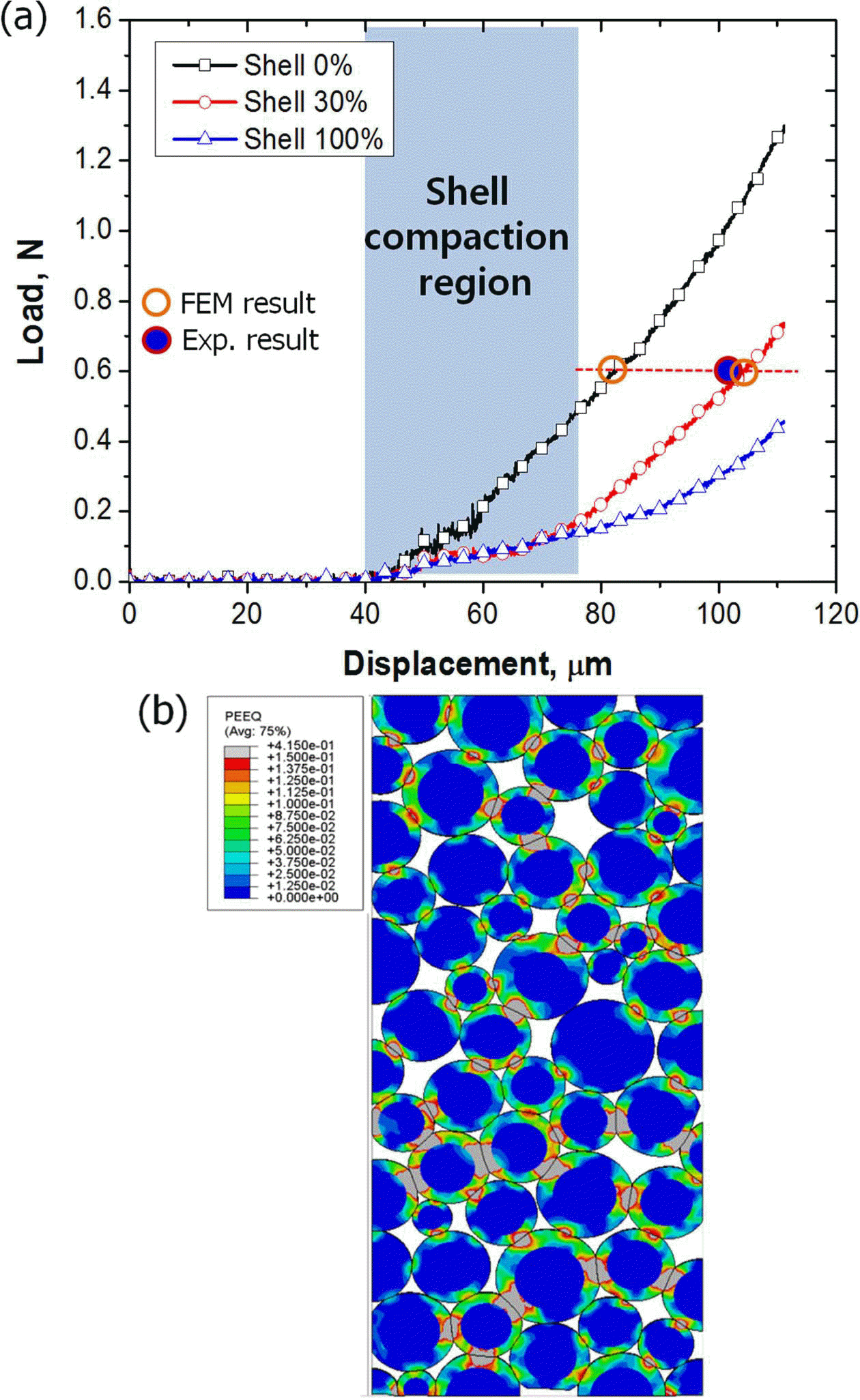Search
- Page Path
- HOME > Search
- [Korean]
- Effect of Core-Shell Structure on Compaction Behavior of Harmonic Powder
- Soo-Hyun Joo, Hyo Wook Park, Soo Young Kang, Eon Sik Lee, Hee-Soo Kang, Hyong Seop Kim
- J Korean Powder Metall Inst. 2015;22(2):105-110. Published online April 1, 2015
- DOI: https://doi.org/10.4150/KPMI.2015.22.2.105

- 278 View
- 2 Download
-
 Abstract
Abstract
 PDF
PDF In this study, effect of core-shell structure on compaction behavior of harmonic powder is investigated. Harmonic powders are made by electroless plating method on Fe powders. Softer Cu shell encloses harder Fe core, and the average size of Fe core and thickness of Cu shell are 34.3 μm and 3.2 μm, respectively. The powder compaction procedure is processed with pressure of 600 MPa in a cylindrical die. Due to the low strength of Cu shell regions, the harmonic powders show better densification behavior compared with pure Fe powders. Finite element method (FEM) is performed to understand the roll of core-shell structure. Based on stress and strain distributions of FEM results, it is concluded that the early stage of powder compaction of harmonic powders mainly occurs at the shell region. FEM results also well predict porosity of compacted materials.
- [Korean]
- Prediction of Martensite Fraction in the Sintering Hardening Process of Ni/Mo Alloy Powder (FLC-4608) Using the Finite Element Method
- Hyo Wook Park, Soo-Hyun Joo, Eon Sik Lee, Ki Hyuk Kwon, Hyong Seop Kim
- J Korean Powder Metall Inst. 2015;22(1):10-14. Published online February 1, 2015
- DOI: https://doi.org/10.4150/KPMI.2015.22.1.10

- 194 View
- 1 Download
-
 Abstract
Abstract
 PDF
PDF In recent years, industrial demands for superior mechanical properties of powder metallurgy steel components with low cost are rapidly growing. Sinter hardening that combines sintering and heat treatment in continuous one step is cost-effective. The cooling rate during the sinter hardening process dominates material microstructures, which finally determine the mechanical properties of the parts. This research establishes a numerical model of the relation between various cooling rates and microstructures in a sinter hardenable material. The evolution of a martensitic phase in the treated microstructure during end quench tests using various cooling media of water, oil, and air is predicted from the cooling rate, which is influenced by cooling conditions, using the finite element method simulations. The effects of the cooling condition on the microstructure of the sinter hardening material are found. The obtained limiting size of the sinter hardening part is helpful to design complicate shaped components.
- [Korean]
- Obtaining Mechanical Properties of Fe Powder Using a Combined Nanoindentation and the Finite Element Method
- Hyeok Jae Jeong, Dong Jun Lee, Eun Yoo Yoon, Eon Sik Lee, Nack Joon Kim, Hyeong Seop Kim
- J Korean Powder Metall Inst. 2013;20(4):280-284.
- DOI: https://doi.org/10.4150/KPMI.2013.20.4.280

- 259 View
- 0 Download
-
 Abstract
Abstract
 PDF
PDF - Stress-strain curves are fundamental properties to study characteristics of materials. Flow stress curves of the powder materials are obtained by indirect testing methods, such as tensile test with the bulk materials and powder compaction test, because it is hard to measure the stress-strain curves of the powder materials using conventional uniaxial tensile test due to the limitation of the size and shape of the specimen. Instrumented nanoindentation can measure mechanical properties of very small region from several nanometers to several micrometers, so nanoindentation technique is suitable to obtain the stress-strain curve of the powder materials. In this study, a novel technique to obtain the stress-strain curves using the combination of instrumented nanoindentation and finite element method was introduced and the flow stress curves of Fe powder were measured. Then obtained stress-strain curves were verified by the comparison of the experimental results and the FEA results for powder compaction test.
TOP
 kpmi
kpmi

 First
First Prev
Prev


